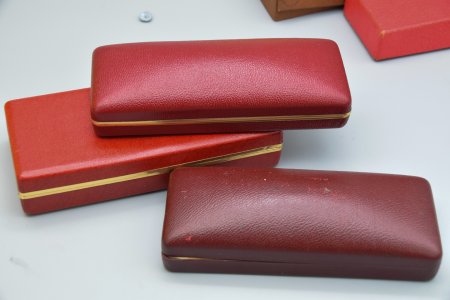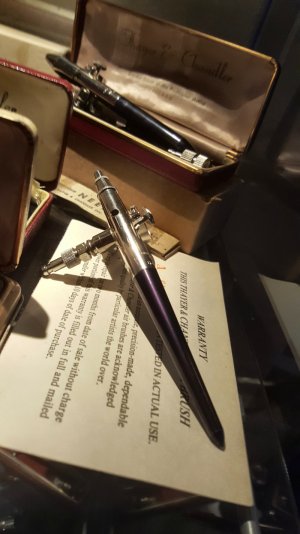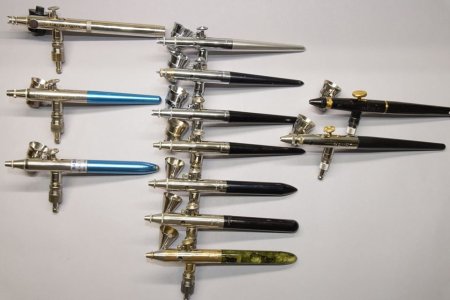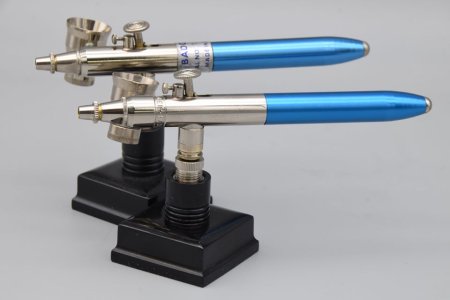Kim McCann
Mac-Valve Maestro!
Another vintage airbrush find. This time with the original packaging it was sent out in.
It is a bit hard to date, however. There are several sort of conflicting things here.
There are two post marks and stamps on the original package, one of the stamps is a 5 cent minute man from 1925, and there is a smudged postmark on it that bears it out. The other stamp is a freedom coil from 1952, but the postmark on that is illegible.
The handle appears to be consistent with the 20s, but the paint cup is the same as others I have from the 30s and 40s. It has a low serial - 4347, so that might support the mid 20s date, but it is also in remarkable condition, so good as it makes me doubt it can be that old. All it needed was a good wash and polish, and the needled needed to be re-finished, but.... other than that, it sprays like it was new. Not much restoration to do.
The case was wrapped in some kind of waxed cloth that pretty much came apart opening it up, so it was stored really well.
My best guess is that maybe it was ordered in 1925, and then at some point later - the 50s, someone resused the box to send it somewhere for repairs or replacement parts? But, that seems kind of odd. I can't account for stamps being 27 years apart.
Got from a private collector, and they seemed to think it was 1920s as well, but based on postage stamps, it could be anywhere from 1925 to 1952?
The address for it is only partly visible, it was for a Lee M. Fowler and for somewhere Chicago as near as I can tell, or at least for an address in a city that contains 'i' and an 'ago'. T&C are in Chicago, so maybe it was a return or a service request or something.
The paperwork inside the box is super badly aged, so it is pretty fragile, but the brush and case themselves are like new.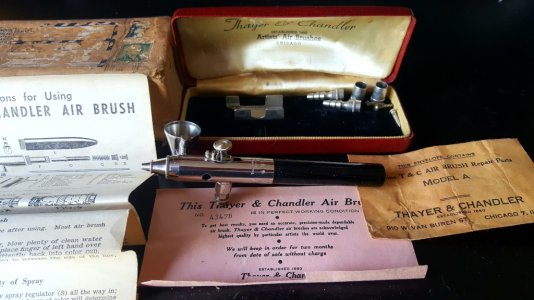
It is a bit hard to date, however. There are several sort of conflicting things here.
There are two post marks and stamps on the original package, one of the stamps is a 5 cent minute man from 1925, and there is a smudged postmark on it that bears it out. The other stamp is a freedom coil from 1952, but the postmark on that is illegible.
The handle appears to be consistent with the 20s, but the paint cup is the same as others I have from the 30s and 40s. It has a low serial - 4347, so that might support the mid 20s date, but it is also in remarkable condition, so good as it makes me doubt it can be that old. All it needed was a good wash and polish, and the needled needed to be re-finished, but.... other than that, it sprays like it was new. Not much restoration to do.
The case was wrapped in some kind of waxed cloth that pretty much came apart opening it up, so it was stored really well.
My best guess is that maybe it was ordered in 1925, and then at some point later - the 50s, someone resused the box to send it somewhere for repairs or replacement parts? But, that seems kind of odd. I can't account for stamps being 27 years apart.
Got from a private collector, and they seemed to think it was 1920s as well, but based on postage stamps, it could be anywhere from 1925 to 1952?
The address for it is only partly visible, it was for a Lee M. Fowler and for somewhere Chicago as near as I can tell, or at least for an address in a city that contains 'i' and an 'ago'. T&C are in Chicago, so maybe it was a return or a service request or something.
The paperwork inside the box is super badly aged, so it is pretty fragile, but the brush and case themselves are like new.



